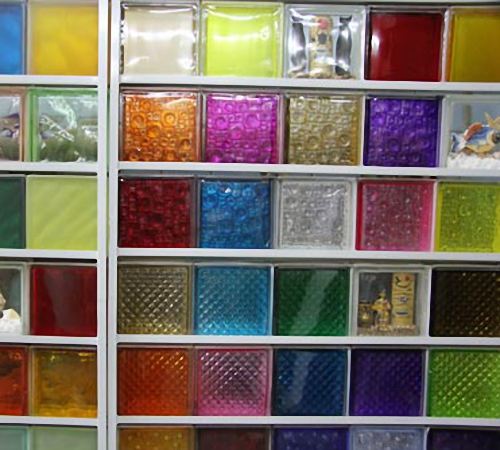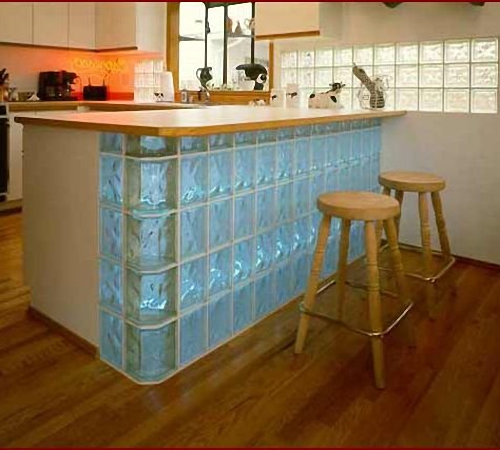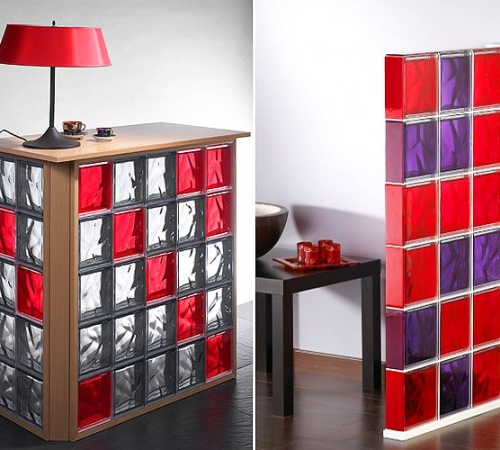Warm floor in the kitchen is a modern level of comfort, turning the usual ...
|
|
There are many insulation materials, the largest sphere of application has ... |
Bezramic glazing attracts with airiness and simplicity of design ... |
The use of glass blocks in the interior

Glass blocks are hollow glass bricks that are widely used in the construction and arrangement of interiors. Such material was widely used several decades ago in the construction of residential buildings, hospitals and various public buildings. The glass blocks of those times did not differ in beauty and style, they were ordinary cloth boxes with a narrow choice of color scheme. But thanks to a number of useful properties inherent in glass blocks, the revival of this material began and its widespread use in interior design. Especially given the fact that modern glass blocks are produced in various versions, have a very attractive appearance and are suitable for the implementation of the most unexpected projects.
Table of contents:
- The advantages of glass blocks
- Varieties of glass blocks
- The use of glass blocks in the interior
- Wall of glass blocks
- Glass block partitions
- Windows from glass blocks
- Decorating with glass blocks
The advantages of glass blocks
- The first advantage of using glass blocks in the interior is a wide selection of design solutions, which practically do not limit the creator of the interior in the embodiment of his ideas. Manufacturers offer glass blocks in a wide range, in various variants of size, shape and texture of the surface of the material.

- The second advantage, which is also important when choosing a material for finishing technical characteristics. Decorative material often carries not only an aesthetic function, it should withstand some loads and cope with external influences. Glass blocks are almost impossible to break, it lowers injuries when laying and operating them. The material withstands temperatures from -40 to +500C and therefore are freely used for laying external walls.
- Installation of glass blocks is very simple. If one of the structural elements was damaged, then it changes easily without completely dismantling the entire masonry. The level of noise isolation allows the use of glass blocks as a soundproofing material in the supporting walls or partitions. Glass brick is ideal for places of high humidity, it does not pass water and is not afraid of condensate. In addition to moisture and noise, glass blocks also delay dust well.
- Glass blocks are also economical material, as they perfectly hold heat inside the room and help reduce heating costs. In the hot season, this effect works in the opposite direction and does not let hot air into the room, keeping cool in it. At the same time, glass blocks are not at all fuel and are materials with a high level of fire safety.
- The use of glass blocks in chemical industry enterprises, medical institutions, laboratories and other similar rooms is possible due to the resistance of this material to the effects of aggressive chemicals. In maintenance, glass blocks are simple and practical. The material is washed with any household products, while any pollution is removed from the surface very simple and easy. The entry of dust inside the whole brick is excluded, since all products are hermetically sealed.
- Glass blocks pass a large amount of light into the room, while they are not transparent, like ordinary glass. The matte surface does not allow a curious prying look to see everything that happens on the other side of the wall of the glass blocks, while the room will be well lit quite. The last and most important plus of glass blocks their low cost in comparison with similar materials for construction and finishes.
Varieties of glass blocks
A specific general separation of glass blocks into certain species does not exist. Materials are distinguished by some separate features, of which 8 main ones are distinguished:
- The dimensions of the brick. Standard and most often found dimensions 190x190x80 mm, 240x240x80 mm, 190x90x80 mm and 240x115x80 mm.
- Form of the product. The most popular glass blocks in the shape of a square, a rectangle and a triangle with rounded or not rounded faces. A more original design of glass blocks in the form of a hexagon or in the form of the letter G.
- Colors and filling. In color scheme, glass block manufacturers are not limited and therefore they produce them in a variety of color solutions. Also, this material is produced by hollow inside or containing various decorative elements. In the photo below, glass blocks with decorative inclusions.

- The internal texture of the surface of the brick. This indicator affects not only the appearance of the material, but also its ability to skip the light flow. The surface is made corrugated, even, matte, glossy, patterned or arbitrary. Also, the inner surface is painted or remains transparent.
- Glass thickness in brick. This indicator affects the weight and strength of the glass block. The most common thickness is 6-7 mm.
- Strength and resistance to loads. This indicator consists of several characteristics, among which the glass variety, its thickness and the structure of the brick itself. At a high level of these characteristics, glass blocks are not destroyed even from a shot from firearms.
- Optical characteristics. This indicator indicates the degree of light permeability of the brick and its effect on the luminous flux. Glass blocks are guides, scattering, etc.
- Application area. This sign determines the purpose of the material and the nature of the premises for which it is intended. There is a sign of different components, among which the thickness of the glass, impact resistance, visual signs, etc.. Three main groups of glass blocks are distinguished interior, decorative and industrial.

The use of glass blocks in the interior
In addition to widespread use in industry, which requires durable material with a high level of fire safety and not subject to destruction from chemical and thermal influences, glass blocks are widely used in the interior. They are used both as a building material and in the form of an additional decorating surface. Glass blocks use:
- For the construction of walls and partitions. Glass blocks are optimally suitable for building walls in rooms with high humidity, where a strong material that does not pass moisture and temperature is needed, and not subject to the formation of rot, fungi and corrosion.

- For laying windows. This material is especially convenient for the construction of panoramic walls in private houses. As mentioned above, glass blocks pass light, but are not transparent. A room with a wall of this material will be very bright, warm and safe.

- As a decorative element. During redevelopment, repairs, erection of arches and various designs. To arrange the interior, the use of glass blocks has no boundaries. They are laid out on the walls like tiles from a tile, used for the construction of door or window slopes. From glass blocks with decorative inclusions, real wall paintings with an amazing voluminous image are created. At the same time, it is very simple to take care of such a picture, and the elements inside will never lose their brightness and appearance, thanks to the hermetic adhesion of the brick.

- To create furniture. Glass blocks are different and therefore suitable not only for walls, but also for furniture. Glass facades are created from thin glass blocks in the doors of cabinets or ordinary interior doors. Another example of this application is the creation of a stationary bar in the studio apartment. Tables, bedside tables and coffee tables are collected from glass blocks. The only drawback of this design is its stationaryness, glass block furniture is installed once and for all.

Wall of glass blocks
The current trend in redevelopment implies to remove some walls and build others, in the place that seems to be the most optimal owners. This type of repair makes it possible to plan the space of the apartment for its needs. In the process, one very important question arises which material to choose for the construction of new walls. Glass blocks in this case are an excellent option.

Wall of glass blocks is a good solution for dark rooms without windows. The wall between the dark and light room is completely or partially laid out of glass blocks, and the shaded room becomes light and cozy. This use of glass brick not only makes the room more comfortable, but also makes it possible to save on electricity, since there is no longer the need to light the lamp in the daytime. The rooms will remain divided both visually and technically.
With the help of glass block, joint bathrooms are separated, they are a magnificent alternative to brick if the wall between the bathroom and the kitchen constantly damps and molds. When building a wall of glass block, it is only necessary to remember that, with all its beauty and transparency, the glass block looks quite cold, therefore it is better to combine it with other types of building materials. For example, one part of the walls with drywall, and the other with glass bricks.
Glass block partitions
The difference between the partition and the wall is that this is not a deaf structure, which is necessarily connected to the ceiling and all adjacent walls. The partition is designed as a dividing room into parts of the formation, zoning it or simply separating some objects from the total area. In this case, the upper part of the partition is performed in a flat plane or figure. The first option is more practical, since the top of the partition is easily equipped under the shelf and allows the most optimally the use of free space in small rooms.

The most common example of erecting glass blocks Zoning of a bathroom or public showers in pools, sports clubs, etc. In public places, this material is convenient in that it easily withstands constant and prolonged contact with water, without losing its properties and appearance. In everyday life, this factor is also of great importance, but the aesthetic side of the issue is also important. The glass blocks in the bathroom will become, as it were, a continuation of the wall, they perfectly harmonize with tiles of any texture and color, provided that the tone of the glass itself is selected correctly. The emphasis is on the bathroom because it is in this room to finish that tiles or ceramics are used, which harmonize well with glass. For the same reason, a good design solution is the use of glass blocks in the kitchen, in the dining room, in a bathhouse or sauna, in rooms with a pool.
Glass blocks are the optimal solution for the bathroom and if there is only one bathroom in the apartment, and a large number of people live. Partitions from this material will make it convenient to use the room at the same time by several people, only in this case they must be erected from embossed inexpensive bricks. In residential premises, glass block partitions are not always appropriate and recommended for such styles:
- Modern directions loft, hi-tech, urban.
- For Baroque, neo-baroque, ar-deco styles, elements of colored bricks are suitable, it is possible to use products with decorative inclusions.
- The ar-nouveau style is complemented by stained glass blocks, these elements will also look good in the classic and oriental style.
The use of glass bricks in living rooms depends on aesthetic preferences. However, styles in which designers do not recommend the use of elements of rustic and natural glass blocks. To diversify the partition from the glass block and make it more original, combine different colors or create a complex mosaic from blocks of different tones, colors and sizes.
In order not to make complex calculations and not to create a color project of the future wall, they use the simplest option and simply in some places the walls of glass bricks insert elements with decorative inclusions. Partitions, like the walls, are folded completely or combined with other types of materials.
Windows from glass blocks
To make a dark dull room lighter, it is not necessary to completely lay out the wall of glass blocks, it is enough to perform a small area with their help, that is, build an inner window. Such a solution is relevant for the wall in the bathroom, hallway, hall, corridor between rooms, etc.

External windows are also performed with glass blocks. This is especially true for the wall in the bathroom, which goes outside. The plus of this method is that it is possible to make a large panoramic window that will not make it possible to look into the house to any passerby. The minus of the glass block is not transparent on both sides, that is, this window will not be transparent and inside.
Decorating with glass blocks
Widely used glass blocks as a decorating element. When laying the wall, small inserts of glass blocks are made, which add structures visually lightness and comfort. Such a wall will not crush creating an oppressive impression. Another type of application of the insert into the wall according to the principle of laying ceramic tiles. The glass block will be drowned a little into the wall, in this case it will not hold light, but it will reflect it without losing its beauty.

With point decoration of walls with glass blocks, there should not be too many of them. The most optimal option is 1 brick per 1 m2 walls. An interesting interior solution drowned in the wall of a glass block with a lamp hidden behind it. Thus, the design unique in their beauty is created. Glass blocks are used for various types of wall decoration as an additional element. For example, when creating painting or gypsum on the wall of painting, when designing arches and fireplaces. In this case, colored blocks with decorative inserts or stained glasses are most often used.
Watch blocks lay out screens for the bath, this design for large and angular capacity looks especially beautiful. Another application in the bathroom is the manufacture of a console for the sink. With the correct selection of color scheme, such a console will look unique. During the construction of stairs, glass bricks are inserted into the steps, the backlight will also look relevant here. Not only steps, but also the wall adjacent to the stairs, do it at any height.
